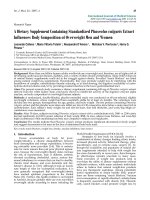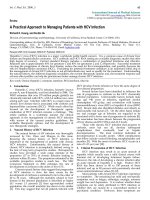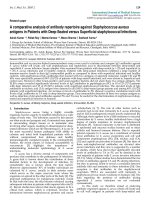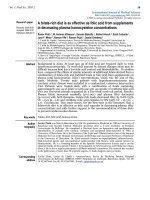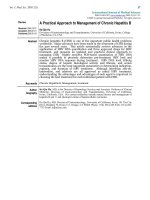Báo cáo y học: " A Dietary Supplement Containing Standardized Phaseolus vulgaris Extract Influences Body Composition of Overweight Men and Women"
Bạn đang xem bản rút gọn của tài liệu. Xem và tải ngay bản đầy đủ của tài liệu tại đây (267.44 KB, 8 trang )
Int. J. Med. Sci. 2007, 4
45
International Journal of Medical Sciences
ISSN 1449-1907 www.medsci.org 2007 4(1):45-52
© Ivyspring International Publisher. All rights reserved
Research Paper
A Dietary Supplement Containing Standardized Phaseolus vulgaris Extract
Influences Body Composition of Overweight Men and Women
Leonardo Celleno
1
, Maria Vittoria Tolaini
1
, Alessandra D’Amore
1
, Nicholas V. Perricone
2
, Harry G.
Preuss
3
1. Cosmetic Research Center, dell’Università Cattolica di Roma, Rome, Italy
2. NV Perricone, MD, Ltd, Meriden, CT 06450, USA
3. Georgetown University Medical Center, Department of Physiology, Washington, DC 20057, USA
Correspondence to: Harry G. Preuss MD, Professor of Physiology, Medicine, & Pathology, Basic Science Building, Room 231B,
Georgetown University Medical Center, Washington, DC 20057.
Received: 2006.12.13; Accepted: 2007.01.23; Published: 2007.01.24
Background: More than one billion human adults worldwide are overweight and, therefore, are at higher risk of
developing cardiovascular diseases, diabetes, and a variety of other chronic perturbations. Many believe that use
of natural dietary supplements could aid in the struggle against obesity. So-called "starch blockers" are listed
among natural weight loss supplements. Theoretically, they may promote weight loss by interfering with the
breakdown of complex carbohydrates thereby reducing, or at least slowing, the digestive availability of carbo-
hydrate-derived calories and/or by providing resistant starches to the lower gastrointestinal tract.
Aims: The present research study examines a dietary supplement containing 445 mg of Phaseolus vulgaris extract
derived from the white kidney bean, previously shown to inhibit the activity of the digestive enzyme alpha
amylase, on body composition of overweight human subjects.
Methods: A randomized, double-blinded, placebo-controlled study was conducted on 60 pre-selected, slightly
overweight volunteers, whose weight had been essentially stable for at least six months. The volunteers were
divided into two groups, homogeneous for age, gender, and body weight. The test product containing Phaseolus
vulgaris extract and the placebo were taken one tablet per day for 30 consecutive days before a main meal rich in
carbohydrates. Each subject’s body weight, fat and non-fat mass, skin fold thickness, and waist/hip/thigh cir-
cumferences were measured.
Results: After 30 days, subjects receiving Phaseolus vulgaris extract with a carbohydrate-rich, 2000- to 2200-calorie
diet had significantly (p<0.001) greater reduction of body weight, BMI, fat mass, adipose tissue thickness, and waist,/hip/
thigh circumferences while maintaining lean body mass compared to subjects receiving placebo.
Conclusion: The results indicate that Phaseolus vulgaris extract produces significant decrements in body weight
and suggest decrements in fat mass in the face of maintained lean body mass.
Key words: starch blockers, weight loss, obesity, amylase inhibitors, bean extract
1. Introduction
Excess accumulation of body fat (over-
weight/obesity), a chronic disequilibrium between
food consumption and energy expenditure, is becom-
ing noticeably more prevalent [1-4]. This is unfortu-
nate for more reasons than just poor physical appear-
ance, because the overweight/obesity states increase
the risk of hypertension, type II diabetes, arthritis,
elevated circulating cholesterol, cancer, serious hor-
monal imbalances in women that can lead to sterility,
chronic renal disease, and even dementia and Alz-
heimer’s disease [1, 5-10]. Although it took an inordi-
nate length of time for widespread realization, it is
now generally recognized that overweight/obesity
have reached epidemic proportions in the United
States [11]. Further, this health problem is not limited
to America, because globally there are over one billion
overweight adults according to many including the
World Health Organization (WHO) [12,13].
Strategies to lose body fat typically involve a
combination of dietary changes limiting caloric intake,
increased physical activity, behavioral therapy, phar-
macotherapy, and, in extreme cases, surgery [1]. Al-
though the availability and popularity of natural die-
tary supplements intended to help with weight loss
has risen dramatically in recent years, their therapeu-
tic effectiveness remains uncertain in many cases.
Some providers of weight loss products tend to
over-hype the utility of dietary supplements without
sufficient evidence, while many academic individuals
refuse to believe that natural weight-loss products
have any therapeutic usefulness. Among potentially
useful supplements to obtain healthy body propor-
tions are those containing "starch blockers," because
over-consumption of rapidly-absorbed carbohydrates
is frequently associated with obesity [14]. Theoreti-
cally, starch blockers could promote weight loss by
Int. J. Med. Sci. 2007, 4
46
interfering with and/or slowing the breakdown of
complex carbohydrates, thereby reducing the diges-
tive availability of carbohydrate-derived calories, at
least early on, and/or favorably influencing the glu-
cose-insulin system [15-20]. Also recent reports sug-
gest the possibility that “resistant starches’ may play
an important role in body weight loss [21].
The present paper reports findings from a ran-
domized, double-blinded, placebo-controlled investi-
gation in which body weight and body fat composi-
tion of generally healthy, overweight human volun-
teers were examined before and after a 30-day oral
treatment with placebo or a test formula containing a
starch blocker
as the principal active ingredient. [Phase
2 Starch Neutralizer
TM
, also known as Phaseolamin 2250
TM
and Phase2
TM
(Pharmachem Laboratories, Inc., NJ)].
2. Methods
Study Design
EVIC ITALIA in Rome, Italy performed this
randomized, double-blinded, placebo-controlled
study in accordance with the Helsinki Declaration and
other applicable laws related to the protection of study
subjects. Volunteers were recruited through a market
research company in Rome, Italy from a group of in-
dividuals who expressed a willingness to participate
in such evaluations. Eighty-two subjects, aged from
20-45, found to be slightly overweight were selected
initially. Overweight was calculated using the follow-
ing formula: ideal weight (kg) = 100/(100 - % normal
body fat) x lean mass. After calculating ideal weight,
the overweight mass was estimated by measured
body weight – ideal weight. The selection criteria
listed in Table 1 were used to exclude or include study
candidates.
Table 1. Exclusion and Inclusion Criteria
Prior to the initiation of study, each subject was
questioned concerning the above exclusion and inclu-
sion criteria.
In order to obtain optimal compliance among
subjects, it was deemed helpful to pre test participants,
i.e., would a given individual comply by maintaining
the overall diet and taking one tablet before a meal
rich in carbohydrates? After providing written in-
formed consent, each volunteer was examined by a
physician with expertise in nutrition, and given a
sheet with nutritional recommendations to be fol-
lowed, including a daily intake of complex carbohy-
drates concentrated in one of two main meals (Table 2).
The study diet provided approximately 2000 to 2200
calories per day. All volunteers agreed to follow the
nutritionist’s recommendations. The candidates were
entered into a 2-week single-blinded, run-in to en-
rollment and randomization. Subjects in this run-in
period unknowingly received just placebo: the inves-
tigators were aware that participants received inactive
ingredients.
Sixty subjects from the original 82 with proven
body weight stability and deemed to be most compli-
ant with the expected criteria were subsequently se-
lected for the study itself. The chosen participants re-
ported to the Center after 10, 20, and 30 days to have
Int. J. Med. Sci. 2007, 4
47
their body weight checked and recorded. The two
groups took the assigned tablets, one tablet per day
before the main meal rich in complex carbohydrates
for 30 consecutive days (Table 2).
The two provided tablet formulas were identified
by the sponsor as Blokcal batch D106B (Test) and
Blokcal batch 1600301 (Placebo). Tablets were identical
in appearance so that the test and placebo tablets were
indistinguishable. An envelope containing the sam-
ple’s qualitative-quantitative formulas and the prod-
uct identification key was delivered to the principal
investigator and kept at the disposal of the researchers
during the test period for any unexpected circum-
stances. Upon completion of the study, the envelope
was opened in the presence of a representative of the
sponsor and of the Principal Investigator, and the
representative formulas of the samples were identi-
fied.
Table 2 A general summary of the meal plan used in the current study.
Int. J. Med. Sci. 2007, 4
48
Test Products
The active substance to be tested was an 800-mg
tablet (Blokcal D106B) containing approximately
445mg (56% w/w) of Phase 2 Starch Neutralizer lV, a
dried aqueous extract of the common bean (Phaseolus
vulgaris). Phase 2 had been standardized to a mini-
mum of 3000 AAlU (alpha-amylase inhibiting units),
validated by a modified USP method (SOP 110, Rev. 5).
Other ingredients present in this preparation were
calcium phosphate (20%), microcrystalline cellulose
(10%), vitamin B3 (7%), as well as small amounts (3%)
of various other ingredients, including chromium pi-
colinate (0.5 mg/tablet). Accordingly, each tablet con-
tained roughly 50-60 mcg of elemental chromium per
serving.
The control substance was an 800-mg tablet
(Blokcal 1600301) containing primarily microcrystal-
line cellulose and maltodextrin (45% w/w each).
Other ingredients included relatively small amounts
(~3%) of Si/ybum marianum (milk thistle), cacao, silicon
dioxide, magnesium stearate, and Curcuma longa
(turmeric) as a coloring agent.
Measurements
Body weight and impedance measurements, skin
echogram, and waist, hip, and thigh circumferences
were measured at the beginning and end of the 30-day
treatment phase. BMI was calculated as the body
weight in kilograms divided by the square of the
height in meters.
Bodv Weight and Composition
Body weights, performed on undressed indi-
viduals, were measured using a calibrated Bodymas-
ter Scale (Rowenta) that also enabled calculation of the
body composition (fat mass, lean body mass) through
bioelectric leg-to-leg impedance measurements. The
patented "foot pad" design sends a low, safe electrical
current through the body to measure its composition.
The electrical current passes more easily through lean
muscle than fat. Body composition is calculated
mathematically, based upon the speed at which the
signal passes through the body [22-25].
Skin Echogram
A 7 Mhz linear probe and a 100 MP Logic Echo-
graph (GE Medical Systems) was used to examine the
morphology and thickness (in mm) of subcutaneous
tissue in areas where adipose tissue tends to accumu-
late, i.e., the abdominal region for men and the right
trochanter region for women. The accuracy of the Skin
Echography is reported by the manufacturer to be ±
one mm.
Waist. Hip. and Thigh Circumferences
The respective circumference of the waist, hips,
and right thigh was measured using a standard
non-stretchable flexible measuring tape. Temporary
tattoos were used to identify the area of reference
from one reading to the next.
Adverse/Side Effects
The study staff monitored subjects throughout
the investigation for the occurrence of any adverse or
side effects.
Statistical Analysis
To minimize differences in beginning values be-
tween subjects, they were stratified into two groups
very similar in size, age, gender, and body weight dis-
tribution. At completion, data from 30 subjects receiv-
ing the Test supplement and 29 subjects receiving the
Placebo supplement were available for statistical
analysis. For each subject, the differences between
pre-treatment (baseline) and post-treatment (30-day)
values for each parameter (body weight, lean body
mass, etc.) were calculated. The differences were al-
ways obtained by subtracting the 30-day values from
the baseline values. A negative difference indicates a
reduction in the parameter after 30 days. Conversely,
a positive difference indicates an increase in that pa-
rameter. This approach allowed test variability to re-
main low and the statistical analysis to be more pow-
erful. The differences between pretreatment and
30-day values in each of the two groups were ana-
lyzed using the paired Student's t-test (intragroup
analysis). The differences in the deltas between the
test and placebo group were analyzed by the unpaired
t-test (intergroup analysis).
3. Results
The Test and Placebo groups were essentially
comparable in starting age, gender, BMI, weight, fat
mass, non-fat mass and various body circumferences
(Table 3). There was a trend for a lesser skin echogram
in the placebo group. One subject in the Placebo group
withdrew from the study for unexplained reasons. No
significant adverse events were reported.
Table 3. Baseline Measures of the Test and Control Groups
Outcome
Test
(N=30)
Placebo
(N=29)
P Value
Age (years) 33.7±1.6 34.2±1.6 0.84
Gender 22F/8M 20F/9M
BMI (kg/m
2
) 25.9±2.0 26.0±2.3 0.42
Weight (kg)
74.1±2.1 73.4±2.4 0.82
Fat Mass (kg) 23.0±0.8 22.0±0.8 0.39
Non Fat Mass (kg) 51.2±2.0 51.5±2.0 0.99
Skin Echogram (mm) 33.1±1.8 28.6±1.7 0.08
Waist Circumference (cm) 85.3±1.8 87.4±3.1 0.55
Hip Circumference (cm) 106.4±1.4 106.5±1.5 0.93
Right Thigh Circumference (cm) 65.8±1.5 65.9±1.7 0.97
Ave ± SEM is shown with the exception of gender where the ratio is
given. Values for the listed outcomes are in parentheses. Only in the skin
echogram was there a trend toward a statistically significant difference.
The results were examined within each group.
While all subjects receiving the active supplement
(Test) experienced some weight loss and reduction in
fat mass (estimated via bioelectric impedance), adipose
tissue thickness (via skin echogram), and waist, hip,
and thigh circumferences, some participants in the
placebo group actually showed increases in these pa-
rameters. Examining intragroup analysis of the
changes in the Test group by the paired t test, the fol-
lowing averages ± SEM were found at the beginning
Int. J. Med. Sci. 2007, 4
49
and end of the study respectively: in kilograms --body
weight 74.1±2.1 vs. 71.2±2.0 (p<0.001); fat mass
23.0±0.8 vs. 20.6±0.7 (p<0.001) and non-fat mass
51.2±2.0 vs. 50.6±2.0 (p<0.001); in millimeters -- skin
echogram 33.1±1.8 vs. 29.3±1.7 (p<0.001); in centime-
ters – waist circumference 85.3±1.8 vs. 82.5±1.7
(p<0.001), hip circumference 106.4±1.4 vs. 104.9±1.4
(p<0.001), and right thigh circumference 65.4±1.5 vs.
64.9±1.5 (p<0.001).
Examining intragroup analysis of the Control
group by the paired t test, the following averages ±
SEM were found at the beginning and end of the
study respectively: in kilograms --body weight
73.4±2.4 vs. 73.2±2.4 (p<0.005); fat mass 22.0±0.8 vs.
21.8±0.8 (p>0.05) and non fat mass 51.5±2.0 vs.
51.3±2.0 (p<0.02); in millimeters -- skin echogram
28.6±1.7 vs. 28.0±1.7 (p<0.04); in centimeters – waist
circumference 87.4±3.1 vs. 87.0±3.1 (p<0.004), hip cir-
cumference 106.5±1.5 vs. 106.4±1.4 (p>0.05), and right
thigh circumference 65.9±1.7 vs. 65.7±1.7 (p<0.008).
As Table 4 illustrates, there was a highly signifi-
cant (p<0.001) difference between the Test and Control
groups after 30 days in all the changes of components
measured, i.e., the group receiving the Test supple-
ment containing Phaseolus vulgaris extract had much
greater loss of body weight, fat mass, adipose tissue
thickness, and waist, hip, and thigh circumference.
The difference in mean lean body mass loss just
proved significant (p<0.05).
Table 4. Effect of Phaseolus vulgaris-containing extract vs.
control dietary supplement on the body composition of
overweight subjects
Measured Parameter Test (n=30) Control
(n=29)
p-value
Body weight (kg)
-2.93 ±
1.16
-0.35 ± 0.38
<0.001
Fat mass (kg) -2.4 ± 0.67 -0.16 ± 0.33
<0.001
Lean body mass (kg) -0.53 ±0.45
-0.19 ± 0.17
<0.05
Waist circumference
(cm)
-2.93 ± 2.13
-0.47 ± 0.39
<0.001
Hip circumference (cm) -1.48 ± 0.66
-0.10 ± 0.47
<0.001
Thigh (right)
circumference (cm)
-0.95 ± 0.80
-0.26 ± 0.46
<0.001
Adipose tissue thick-
ness
(via skin echogram)
(mm)
-4.2 ± 6.51
-0.66 ± 2.81
<0.001
Ave ± SEM is shown. Among various parameters, a comparison of the
individual changes within groups (30 day values – baseline) was made
between the test and control groups. The negative values indicate a loss
from baseline within the group. The significance of the 30-day changes
between the test and control groups were compared via the unpaired
Student’s t test and listed in the last column.
4. Discussion
Our results indicate that a test dietary formula
containing 445 mg Phase 2 Phaseolus vulgaris extract
taken daily by overweight human subjects concur-
rently with a carbohydrate-rich portion of a 2000- to
2200-calorie diet is more effective at reducing body
weight and body fat mass than placebo. Importantly,
the major weight changes are brought about more by
fat loss rather than diminution in non-fat body mass
as indicated by different means: impedance measure-
ments, waist, hip and thigh measurements, and sub-
cutaneous fat measurements. Earlier, Udani et al. [20]
reported reduced body weights and serum triglyc-
erides in 14 obese adults receiving 1500 mg of Phaseo-
lus vulgaris extract (Phase 2
TM
) twice daily with meals
for eight weeks. However, values did not reach statis-
tical significance. The clearer statistical differences
found in the present study compared to Udani’s ear-
lier report where larger doses of extract were used [20]
may be due, at least in part, to the care taken to enroll
subjects who would comply with a strict protocol.
The purpose of the run-in period was to exclude
non-adherent subjects. Obviously, the power to detect
a meaningful difference between the active interven-
tion and control groups would be enhanced by re-
moving non-adherent participants. We accept that the
ultimately randomized participants will be less repre-
sentative of the general population of patients. Be-
cause the purpose of this trial was to measure efficacy
of the agent under study, we chose to measure our
parameters under optimal circumstances. Future
studies could examine effects under more regular
conditions to test the overall effectiveness of the
product [26]. Evidence suggesting strong adherence to
the present protocol can be gathered from the statisti-
cally significant mass losses noted even in the Placebo
group relegated to the same caloric-restricted diet as
the Test group.
Many published studies concerning methods to
combat obesity provide only scale weight loss as the
principal end point. The assumption that scale weight
loss is synonymous with fat loss, however, is not al-
ways true [26,27]. Scale weight decreases may reflect
non fat mass loss as much as fat loss. In the present
study, indications by many different measurements
are that the weight loss is principally due to loss of fat
mass. Leg to leg impedance measurements suggest
this is true. Although not the “gold standard” like
DEXA [26], perusal of the literature suggests this
methodology gives a good first approximation [22-25].
In addition, the use of echograms to estimate subcu-
taneous adipose tissue and the changes in body cir-
cumference in various locations corroborate the con-
clusions derived from the impedance data.
Further evidence of significant fat loss can be
seen in the changes of the calculated body mass index
(BMI). BMI is a generally accepted marker of obesity
health risk [28]. The lowest health-risk category is
among individuals whose BMI’s range from 20-25,
and the highest risk category is found in individuals
whose BMI’s exceed 40. A BMI greater than 40, termed
as “morbid obesity” or clinically severe obesity, affects
more than 15 million Americans. In the test group,
BMI was lowered from an initial 25.9±2.0 (SEM) to
24.9±1.9 (SEM) (p<0.001). The placebo group showed
no statistical difference from the initial 26.0±2.3 (SEM)
to 25.9±2.3 (SEM) (p=0.79). Important to our argument,
BMI is known to significantly relate to fat mass – more
so than scale weight alone [29]. The marked loss of fat



